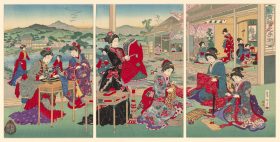As Artemisia Gallery is on the southern side of High Street, it’s technically in the Melbourne suburb of Windsor, but it looks out at its neighbouring suburb Prahran across the road. Whether by accident or design, this is nicely symbolic of the Gallery’s diversity, since the suburbs Windsor and Prahran have very different characters. And, fittingly, the three artists in the Gallery’s latest exhibition, Samira Khadivizand, Elaine Batton and Bridie Nelson (an artist in Melbourne’s prolific Blender Studios), are indeed very different, but, just like the two suburbs, work very well next door to each other.
Iranian-Australian Khadivizand seems to weave her thoughts onto the canvas; a lot of her work paradoxically floats on the edges between random and meticulously planned. Born with a rare eye irregularity, her artistic style mirrors – to whatever extent – the world as she sees it. This new exhibition is decidedly different to a great deal of her previous work, most notably with the almost total exclusion of human forms or recognisable built environments.
Many of her past work resembles 1920s or 30s noir paintings of jazz artists, perhaps influenced by cubism or vorticism, in the visual vein of perhaps the Hungarian artist Hugó Scheiber or the contemporary US artist Cbaibi Bayoc; for instance, his album cover art for Prince’s album The Rainbow Children. Picture that album cover, but with the edges blurred, the figures smudged and rearranged and you have a slight glimpse into some of Khadivizand’s earlier works.
Reading her artist’s statement explains why this exhibition is all but devoid of clearly human subjects – she says it depicts ‘various physical, sensory, and emotional activities and interactions from my daily life’, including ‘my movements, actions, and reactions with objects and people, both in the physical world and virtual space’. In this way, she is painting everyday routines, which makes her show’s title Impressive Insignificance make sense.
Perhaps her works are visually manifesting emotions, or even verbs. To conventionally paint a verb, for instance “run”, you paint an object that’s doing the verb, not the verb itself. As I understand her artist’s statement, perhaps she is trying to bridge this gap – to paint the inherently unpaintable.
Of course artists have been doing this throughout the centuries (although what Jackson Pollock was trying to paint is still up for debate), but Khadivizand’s works are alien yet welcoming – abstract yet somehow familiar. She speaks her own visual tongue, and in this body of work she uses that language to create a visual world that obeys its own grammatical rules, resulting in art that is aesthetically sensational and intellectually stimulating. Each painting is a puzzle to unlock, a mystery to explore.
Batton’s work is primarily a photographic exhibition of Antarctica, although she has included some non-Antarctic photos from her archives. Well aware that photos of Antarctica are a dime a dozen, she has consciously chosen photos that convey, or elicit, an emotion, attempting to recapture what she felt in that environment, a ‘silent world that echoes loudly with wildness’.
She has chosen her photos well, from a probable selection of hundreds – the shot Ice Whip shows a more unusual iceberg’s texture and Icicality conveys a sense of mystery, or even foreboding. Her non-Antarctic photo Southside shows excellent composition and lighting, the work of a truly accomplished photographer.
The third artist, Nelson, has a collection of works entitled Keepsakes and, as the name suggests, the subject matter is objects kept from times in the past or, as the artist puts it, ‘the pieces act as a diary of objects and shapes’. Some of these are identifiable, such as Winnie-the-Pooh, what look like trumpet valves, a ride-on donkey toy and, more unusually, a stack of metal chairs. Nelson’s pieces are small works on paper, a great number of them giving a sense of playfulness from not just the subject matter but also the composition, with the artist presumably having fun choosing what to put where and with what.
Artemisia Gallery is run by creative director Isabella Imperatore and gallery manager Ash Forbes, who are both artists themselves – which shows. The three artists featured in this exhibition are wonderfully different in mediums, themes, subject matter and styles, but together they form a cohesive artistic whole. Though relatively new – the Gallery’s first opening was just back in April – it has managed to consistently attract high quality Melbourne artists since then.
Read: Exhibition review: Paula Irene Payne, Logan Art Gallery
Go and visit them, and don’t forget to check out Yang Qiu’s quirky sculptures sitting in the window. They give a good introduction to the gallery.
Samira Khadivizand: Impressive Insignificance
Elaine Batton: Art of Antarctica (and art of the archives)
Bridie Nelson: Keepsakes
Artemisia Gallery and Event Space
The exhibition will be open until 4 August 2024.





